Three billion plastic straws are used in Taiwan every year. Assuming an average length of 18cm each, all of those straws, placed end to end, would be sufficient to encircle the Earth 13.5 times. Such a large number of disposable straws is not only a waste of resources: should these non-biodegradable straws end up in the ocean, they could cause serious pollution and damage to the ecosystem.
An Environmental Protection Administration ban on providing single-use plastic straws to customers drinking within the premises is set to go into force on July 1 next year, encouraging people to reduce the use of disposable straws or to switch to environmentally friendly ones.
The following six types of environmentally friendly straws are currently available on the market.
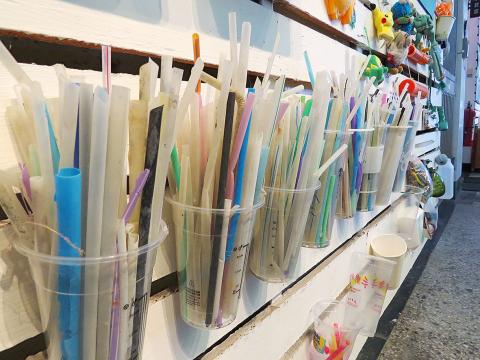
Photo: Tsai Wen-chu, Liberty Times
照片:自由時報記者蔡文居
■ Glass straws
The crystal clear glass allows the drink’s color to be seen through the glass, and also makes it easy to see whether the interior needs cleaning. A brush is often included when purchasing these environmentally friendly straws.
The biggest inconvenience with these is their fragility; glass straws are not suitable for use by young children.
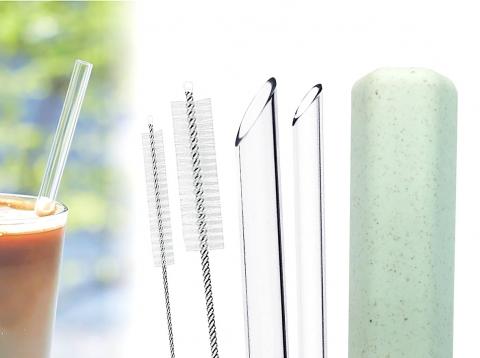
Photo: Tu Ying-Ju, Liberty Times
照片:自由時報記者涂盈如
■ Stainless steel straws
Stainless steel is a very strong and durable material, so you don’t have to worry about cracks forming, but because their main ingredient is iron, there is a concern that acidic drinks such as lemon juice may cause corrosion of the inner side of the straw. In response to these problems, a toxicology expert says that, as with choosing pots, it is best to choose stainless steel conforming to the SAE 304 (or above) standard, and clean them after use.
■ Bamboo straws
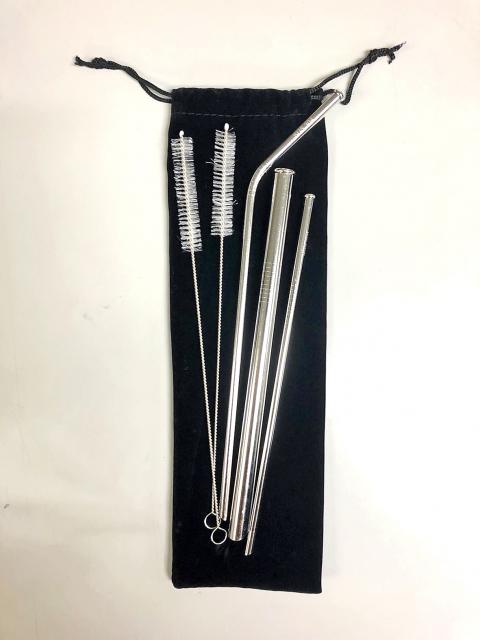
Photo: Ting Wei-chieh, Liberty Times
照片:自由時報記者丁偉杰
Bamboo is the most common plant in Taiwan’s mountainous areas, and it is also the fastest growing plant in the world. From furniture to daily necessities, bamboo has a wide range of uses. The Yuantai bamboo goods store in Jhushan, Nantou County, uses Taiwan’s arrow bamboo to make bamboo straws. These are 100 percent biodegradable.
■ Sugarcane straws
Young entrepreneurs at the Central Taiwan Innovation Campus in Jhongsing New Village, Nantou City, founded the brand “100 plastic free” and developed the latest environmentally friendly straws made from sugarcane fiber.
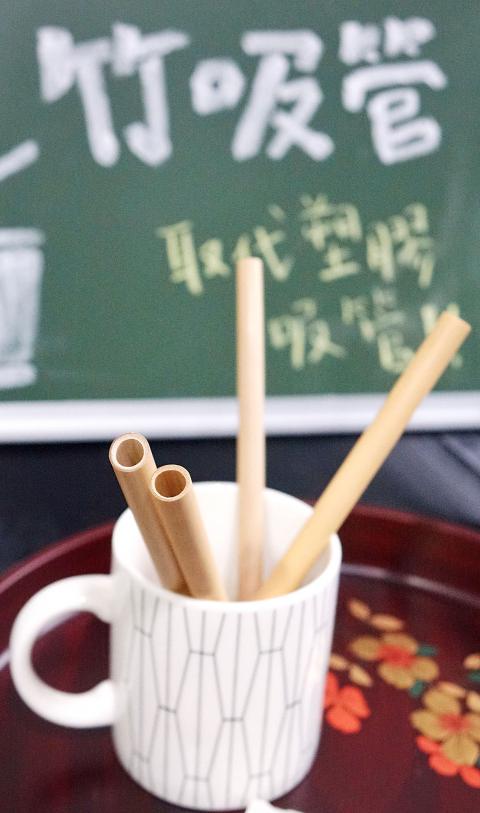
Photo: Liu Hsin-de, Liberty Times
照片:自由時報記者劉信德
■ Silicone straws
In recent years, tableware made of “food grade silicone” has become widely available. Qualified silicone tableware products are soft and heat resistant. Compared with most of the environmentally friendly straws on the market, silicone straws are safer, more suitable for children, and easy to carry.
■ EPA plastic straws
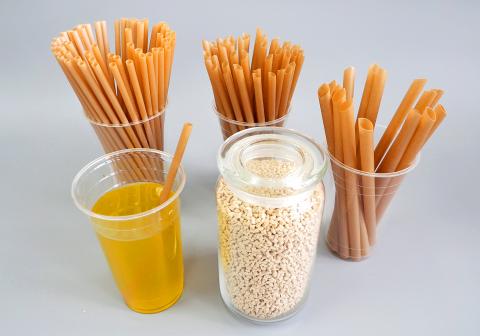
Photo: Chen Li-feng, Liberty Times
照片:自由時報記者陳麗鳳
Environmental Plastics (EPA) is an environmentally friendly plastic developed by Asian University in Taichung and green biotech companies. Its main components are clam shells and shellfish shells, finely ground, mixed with calcium carbonate, fruit enzymes, mycelium etc., and formulated into non-toxic, biodegradable plastics.
(Translated by Lin Lee-kai, Taipei Times)
台灣目前一年約用掉三十億根塑膠吸管,以一支十八公分長的吸管來計算,約可以繞地球十三圈半!大量的一次性吸管不只浪費資源,這些無法分解的塑膠吸管也可能流入海洋,造成嚴重的生態汙染。
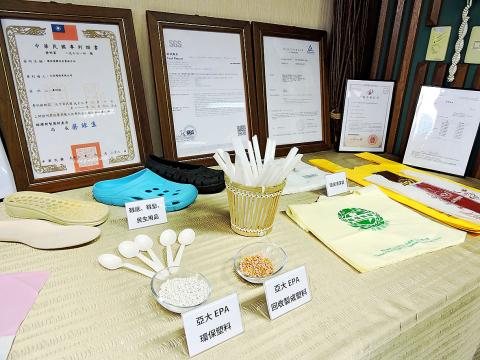
Photo: Chang Ching-ya, Liberty Times
照片:自由時報記者張菁雅
因此環保署將在二○一九年七月起,實施「內用禁止提供塑膠吸管」的新法,鼓勵大家減少拋棄式吸管的用量,或改用環保吸管。
環保吸管怎麼選?以下介紹目前市面上常見的六種環保吸管,讓我們一起愛地球吧!
■ 玻璃吸管
晶瑩剔透的玻璃材質,讓喝飲品時也能透過玻璃看見飲料的顏色,也可以清楚看見吸管內壁是否有殘留污垢,方便清洗。(通常購買環保吸管都會附贈一隻清洗用毛刷。)
至於玻璃材質的缺點,最不方便的就是「易碎」了,因此不適合年紀較小的孩子。
■ 不鏽鋼吸管
不鏽鋼是非常堅固耐用的材質,不用擔心碎裂,但因主要成分是鐵,隱憂在於檸檬汁等酸性飲料可能會造成吸管內層的腐蝕!針對這些問題,毒物專家表示,跟選鍋具一樣,最好選擇304等級(或以上)的鋼材材質,用畢後清洗乾淨。
■ 竹子吸管
竹子是台灣山區最常見的植物種類,也是世界上生長速度最快的植物,從家具到生活用品,竹子的用途廣泛。位在南投縣竹山的元泰竹藝社便運用台灣的箭竹製成竹子吸管,百分之百可以自然分解。
■ 甘蔗吸管
一群來自南投市中興新村中台灣創新園區的年輕人,創立了「100%植」這個品牌,利用甘蔗纖維研發出最新的環保吸管。
■ 矽膠吸管
這幾年以「食品級矽膠」製作的矽膠餐具相當常見,合格的產品有耐高溫、柔軟的特性。相較市面上多數的環保吸管都屬硬質,「矽膠吸管」的安全性較高,不僅適合兒童使用,也攜帶方便。
■ 亞大EPA塑料吸管
「亞大EPA」是由台中市亞洲大學和環保生技業者共同研發出的環保塑料EPA(Environmental Plastics),主要成分為蚵殼、貝類殼等,磨成細粉後摻入碳酸鈣、水果酵素粉、菌絲體等,配製成無毒、可自然分解的塑料。
(自由時報記者陳凱詩)

In an effort to fight phone scams, British mobile phone company O2 has introduced Daisy, an AI designed to engage phone con artists in time-wasting conversations. Daisy is portrayed as a kindly British granny, exploiting scammers’ tendency to target the elderly. Her voice, based on a real grandmother’s for authenticity, adds to her credibility in the role. “O2” has distributed several dedicated phone numbers online to direct scammers to Daisy instead of actual customers. When Daisy receives a call, she translates the scammers’ spoken words into text and then responds to them accordingly through a text-to-speech system. Remarkably, Daisy

Bilingual Story is a fictionalized account. 雙語故事部分內容純屬虛構。 Emma had reviewed 41 resumes that morning. While the ATS screened out 288 unqualified, she screened for AI slop. She could spot it a mile away. She muttered AI buzzwords like curses under her breath. “Team player.” “Results-driven.” “Stakeholder alignment.” “Leveraging core competencies.” Each resume reeked of AI modeling: a cemetery of cliches, tombstones of personality. AI wasn’t just changing hiring. It was draining the humanity from it. Then she found it: a plain PDF cover letter. No template. No design flourishes. The first line read: “I once tried to automate my

Every May 1, Hawaii comes alive with Lei Day, a festival celebrating the rich culture and spirit of the islands. Initiated in 1927 by the poet Don Blanding, Lei Day began as a tribute to the Hawaiian custom of making and wearing leis. The idea was quickly adopted and officially recognized as a holiday in 1929, and leis have since become a symbol of local pride and cultural preservation. In Hawaiian culture, leis are more than decorative garlands made from flowers, shells or feathers. For Hawaiians, giving a lei is as natural as saying “aloha.” It shows love and

1. 他走出門,左右看一下,就過了馬路。 ˇ He walked outside, looked left and right, and crossed the road. χ He walked outside and looked left and right, crossed the road. 註︰並列連接詞 and 在這句中連接三個述語。一般的結構是 x, y, and z。x and y and z 是加強語氣的結構,x and y, z 則不可以。 2. 他們知道自己的弱點以及如何趕上其他競爭者。 ˇ They saw where their weak points lay and how they could catch up with the other competitors. χ They saw where their weak points lay and how to catch up with the other competitors. 註:and 一般連接同等成分,結構相等的單詞、片語或子句。誤句中 and 的前面是子句,後面是不定詞片語,不能用 and 連接,必須把不定詞片語改為子句,and 前後的結構才相等。 3. 她坐上計程車,直接到機場。 ˇ She took a cab, which took her straight to the airport. ˇ She took a cab and it took her straight